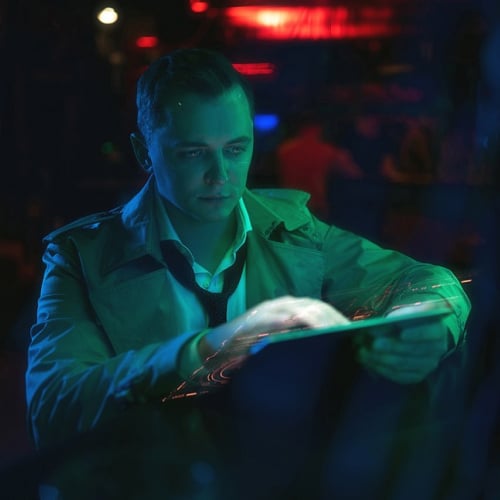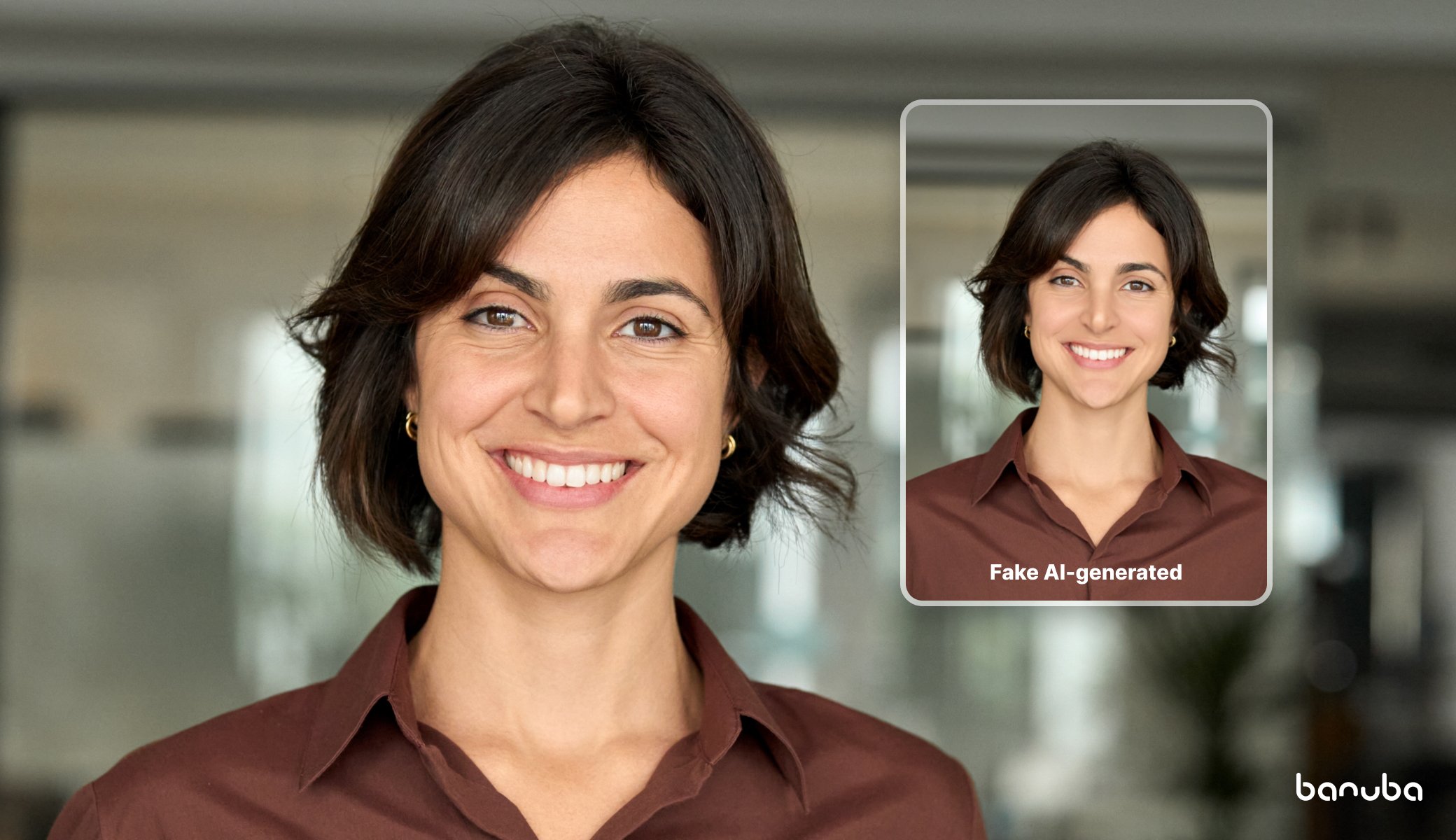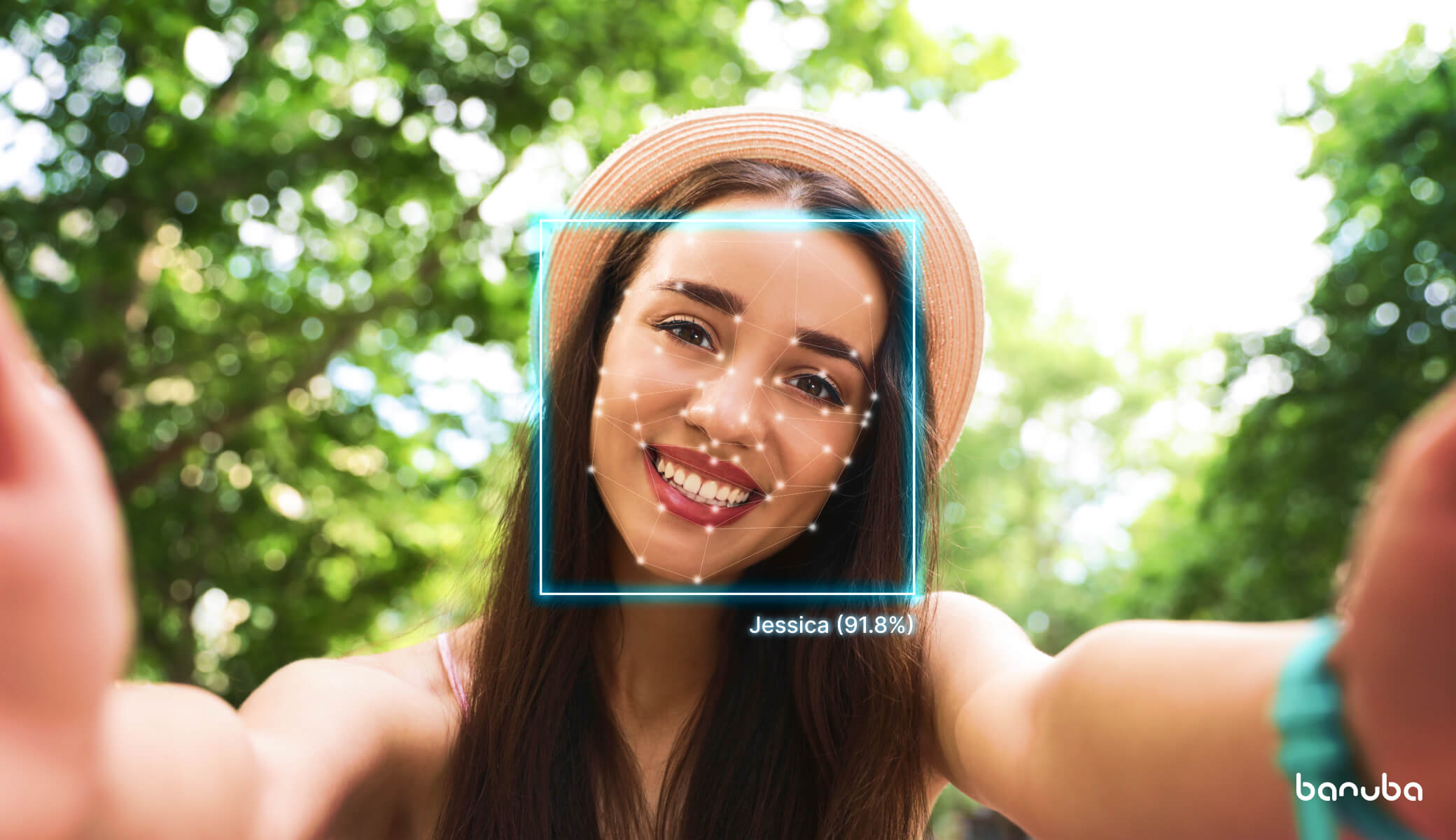16 Best Facial Tracking Software [2024]
Facial tracking has many uses, from applying 3D masks and effects to touchless UI and payments.
However, developing it is a complicated feat that requires an in-depth understanding of computer vision and deep learning and takes a lot of time.
In this guide, you'll learn the 16 best facial tracking software so that you can launch your app within several days.

[navigation]
Facial Tracking Software: What Is It?
Technically, “facial tracking software” refers to determining the precise location of a person’s face on the screen.
However, it is often conflated with face recognition software (one that matches a face to an image in the database) and face detection tools (those that find out whether there is a face on the picture at all).
Because of this, we have decided to not limit this article to a single niche and instead cover the broad spectrum of applications. No matter what exactly you are looking for, you’ll find something useful here.
Note that we will be looking at libraries and SDKs that could add facial tracking capabilities to an application, not consumer-targeting apps.
16 Examples of Best Facial Tracking Software [2024]
Now, let’s see the best-known examples of facial tracking software, both proprietary and open-source.
1. Banuba Face AR SDK
Banuba Face AR SDK
Banuba is a well-established computer vision lab that focuses on face-related augmented reality.
Its Face AR SDK is a major product with an impressive feature set and a long list of high-profile users. It focuses on face tracking technology, augmented reality effects, and has hand tracking capabilities.
Banuba also offers an effects studio that allows users to create their own masks and filters.
- Compatible with iOS, Android, Windows, Mac, Web, Unity
- Background segmentation, beauty AR, face filters, 3D avatars, and more
- One of the few commercially available SDKs that offers background segmentation for web
- Asset store with 1000+ filters and effects
- Gesture recognition
- Selfie and full-body segmentation
- Works in real-time and post-processing
- Has native integration with Agora SDKs
- Clients include Meta, Gucci, Samsung
- 14-day free trial
- Contact for pricing
2. Meishe
![]() Meishe
Meishe
Meishe is a company from Beijing with many face tracking and AR products. Its impressive internal R&D team gained recognition both in China and outside it.
Besides ARkit facial tracking software, Meishe also has a video editing SDK and simulated characters.
- 2D/3D masks, background separation, triggers, beautification, gesture recognition, etc.
- Works on mobile platforms, web, desktop
- Clients include Asus, Xiaomi, Oppo
- Free trial
- Contact for pricing
3. DeepAR
![]() DeepAR
DeepAR
DeepAR offers some of the best facial tracking software for AR try-on, advertising, and video chats. They have been on the market since 2014 and employ scientists from MIT, ESIEE Paris, and other prestigious universities.
- Supports mobile platforms, desktop, and web
- Face tracking, 3D/2D masks, background segmentation, gesture recognition, AR characters, etc.
- Asset store with premade effects
- Clients include Lego, Google, and Coca-Cola
- Free for 10 monthly active users (MAUs) and under
- Pricing based on the number of MAUs
4. ImageMetrics/Lunar
![]() Lunar
Lunar
This company has been in business since 2000 and creates AR tools for advertising, virtual try-on, and social media.
They offer Lunar, an augmented reality ecosystem that combines face tracking, planar tracking, virtual try-on, and other complementary features.
- Supports mobile platforms (including hybrid frameworks like React Native and Xamarin)
- Virtual try-on, AR masks, 3D scenes, etc.
- Web-based CMS for content control and updates
- Clients include L’Oreal, Baidu, Nissan
- Contact for pricing
5. MoodMe
![]() MoodMe
MoodMe
MoodMe is a Luxembourg-based company that specializes in face AR and emotion recognition. They have been working with facial tracking technology since 2011 and filed several patents for their inventions. The MoodMe team won many awards for AR and artificial intelligence research.
- Runs on Android, iOS, Unity, and web
- 3D face filters, emotion recognition, detection of age, race, and sex; virtual background, beautification, etc.
- Demo apps on PlayMarket and AppStore
- Clients include FIFA, Qatar Airways, Gucci
- Contact for pricing
6. Luxand
![]() Luxand
Luxand
Luxand is based in the US and has been working in the industry since 2005.
It is known for its three AR SDKs: Face SDK, FaceCrop, and Mirror Reality. Luxand also has many B2C apps that showcase its technology (e.g. BabyMaker, YouMask, and Age-o-Meter).
- Works on Android, iOS, Web, Desktop
- Face filters, avatars, beautification, facial feature detection, etc.
- Many demo apps
- Dedicated APIs for avatars, aging, beautification, live cards
- Clients include Ford, LG, Universal
- 14-day free trial
- Contact for pricing
7. Visage Technologies
![]() Visage technologies
Visage technologies
This Swedish company was founded in 2002 and is now offering a line of SDKs for facial tracking. The core use cases for them include virtual try-on, driver monitoring, face filters, and access control.
- Supports mobile, web, Unity, and desktop
- Face tracking, 3D masks, age and gender recognition, facial tracking, gaze tracking etc.
- Clients include BMW, McDonald’s, Philips
- Free trial available
- Contact for pricing
8. ARGear/Seerslab
![]() ARGear
ARGear
Seerslab is a Korean AR company that has been working in the domain since 2014. Its main product is ARGear SDK but the company also offers an analytics platform that tracks the performance of AR-enabled content.
- Runs on Android, iOS, and Unity
- Face tracking, AR masks, triggers, virtual backgrounds, beautification, etc.
- Clients include eBay, LG, Pepsi
- Library of premade content
- Limited free use
- The price depends on the use of content and network
9. FaceUnity
 FaceUnity
FaceUnity
FaceUnity is a well-known Chinese computer vision company. They have gathered their team of AR experts in 2016 and have since then released a number of solutions for streaming, social media, etc. They are especially good at making avatars.
- Available on mobile devices
- Beautification, AR masks, gesture recognition, body/face morphing, etc.
- Photo-to-avatar function that creates animated characters
- Contact for pricing
10. ZapWorks
![]() ZapWorks
ZapWorks
ZapWorks was released by AR advertising company Zappar. It is a powerful AR platform that works with humans as well as inanimate objects. ZapWorks is well-documented and is especially popular for Web Ar.
- Available for web, mobile platforms, and Unity
- Face filters, paper-based AR, physics, etc.
- Clients include Deloitte, PWC, and Nestle
- Free trial available
- Pricing depends on the specific features and software packages
11. ARCore
![]() ARCore
ARCore
ARCore is an open source face tracking platform by Google. While not being strictly face-focused, it has face tracking and recognition capabilities.
- Runs on Android (7+), some iOS devices, and Unreal
- Free and open-source
- Spatial AR, 3D masks, and virtual try-on
12. ARKit
![]() ARKit. Source
ARKit. Source
ARKit is Apple’s open source face tracking toolkit, launched with iOS 11. It is a solid foundation for a variety of AR apps.
- Runs on certain Apple devices (depends on features)
- Face tracking, body tracking, geotracking, object placement, etc.
- Free to use with XCode.
13. OpenCV
![]() OpenCV
OpenCV
OpenCV is a popular computer vision library that was initially released in 1999. It is well-documented and serves as a basis for many other tracking software.
- Free and open-source
- Several face detection methods
- Can be integrated with apps on any platform
14. FaceTracker
A lightweight C++ library for tracking faces in real-time. It is based on OpenCV 3 and has been deprecated as moving to OpenCV 4 was too challenging.
- Wrappers for Android, Cinder, Python, OpenFrameworks
- Compatible with OpenCV 2 and 3
- Works on mobile devices
- The license allows commercial use
15. Face detect’n’track
A C++ library for face detection and tracking with an apt name.
- Decent documentation
- A detailed explanation of the underlying algorithms
- The license allows commercial use
16. MindAR
![]() MindAR
MindAR
A well-developed Web AR library with over 700 stars on GitHub. One of the few open-source and free augmented reality SDKs with features on par with commercially available ones.
- Does face tracking, paper-based AR, virtual try-on, and more
- Extensive and detailed documentation
- Written completely in JS
Proprietary vs Open Source Face Tracking Software
The first step in choosing the perfect face tracking SDK is deciding on whether you want to go the open-source or proprietary route.
Open-source software is one whose code can be viewed and modified by anyone with the right skills. However, there is a lot of confusion surrounding the licensing conditions. “Open-source” doesn’t necessarily mean “free”, as there are various distribution models.
For example, Mongoose (an embedded open-source C library) shows its entire code and is free for trial and non-commercial use. However, those who want to use it in paid products have to purchase a license.
OpenDental, an open-source electronic health records system, also requires regular payments.
Note that even free-to-use software will cost you something, as there can be training costs for users, developer salaries for your team, support & maintenance, etc.
This is why people can choose an open-source facial tracking library:
- Free (most of the time). While this isn’t true in 100% of cases, most open source face tracking and tracking libraries cost nothing.
- Modification. Your team can freely change all the elements of the open-source libraries, from UI to facial tracking models.
- Community support. Open-source projects tend to have a large community of developers and users around them. You can rely on this community to find solutions to your problems.
- Vendor independence. You will be able to keep working on your project even if certain libraries stop being developed by the community.
However, there are also drawbacks to it:
- Vulnerability. When everyone can access the source code, this also includes malicious actors. In face tracking and facial tracking software, this can lead to private data leaks.
- No warranty. If you use open-source software to track and detect faces, you also carry all the responsibility for its work. If something breaks, you will have to fix it yourself.
- Modification costs. In most cases, the library/framework/SDK like that will need extra work to make it usable in your application. The amount of such work could be substantial and end up costing you more than integrating a proprietary counterpart.
Proprietary software, on the other hand, stands for products that are sold for profit. It carries certain inherent advantages:
- Integration speed. The main advantage of proprietary face tracking SDKs is the speed with which they can be married to your project. Everything can usually be done in under a week.
- Support and warranty. Vendors will maintain their products in top condition and help you with integration.
- Predictability. With proprietary software, you will know the scope of the features, range of devices they work in, how often it is updated, etc. Open-source systems don’t allow for this kind of planning.
- Straightforward costs. You will know exactly how much the license will cost and will be able to budget your work accordingly.
- Integrations. Face tracking SDK vendors often partner up with other companies to make it easier for customers to use the complementary products. For example, Banuba has native integration with Agora.
- Competitive advantages. Competition forces companies to make their products better if they want to survive. As a result, they can boast unique or improved features: high-accuracy segmentation, lightweight neural networks, more efficient ARkit facial tracking algorithms, etc.
Still, there are also disadvantages:
- Vendor lock-in. Once you have committed to a vendor, switching to another one would require a serious rewrite of your project. Moreover, they are bound to have different feature sets, so if you want to keep everything, you might end up tied to one provider.
- Relative inflexibility. Typically, you can customize a proprietary face tracking module. However, the extent of it is very limited and mostly focuses on UI. Deeper customization is possible but usually requires a separate contract with the vendor.
- Paid. Proprietary libraries and SDKs almost always require payments. In the long term, this can add up.
How to choose the best face tracking software?
There isn’t any product that will be the top choice for everyone. There are many factors that would affect the selection. They include:
- Feature set. The capabilities of the chosen facial tracking SDK or library. More isn’t always better, as extra functionality will enlarge the size of the app or cause you to overpay for things you don’t need.
For example, if you want to build your own custom system, open-source facial tracking libraries would be more fitting than proprietary ones, even though they tend to have fewer features. - Feature quality. Two companies offering the same feature (e.g. 3D masks) can drastically differ in their execution. The effects can look better or worse, consume more or fewer resources, and work faster or slower.
This means testing the product is an absolute must when making a decision. - Technical parameters. Device and platform support, compatibility with cross-platform mobile frameworks, third-party integrations, and other things that make life easier for your technical team.
This can save thousands of dollars in development costs. - Commercial parameters. Price, pricing model, support quality, trial conditions, etc. Once you know what you are paying for, you will be able to make an informed decision on whether the price is worth it.
Why Banuba's Facial Tracking Software
Both the giants like Gucci or Meta and smaller businesses choose Banuba Face AR SDK. And for a number of good reasons.
- Unique features. Certain technologies, for example replacing backgrounds and face masks in Unity and Web, you can’t buy from anyone but Banuba and, possibly, one or two other companies.
- Best-in-class implementation. Banuba’s face tracking technology is second to none. It stops camera shaking, locates people of all races and sexes, works in low-light and high-occlusion, and doesn’t drain many resources.
- Ready-made assets. You can license the effects from the Banuba asset store or order custom ones.
- Quality support. We assist in integrating our SDK, share advice, and provide detailed documentation. If you need it, we can develop unique features as a separate contract.
Conclusion
It is hard to decide on the best facial tracking software for you. With this article, you will have a good starting point.
Select one of the products we mentioned or look for something else. And if you think that Banuba is right for you, send us a message!





